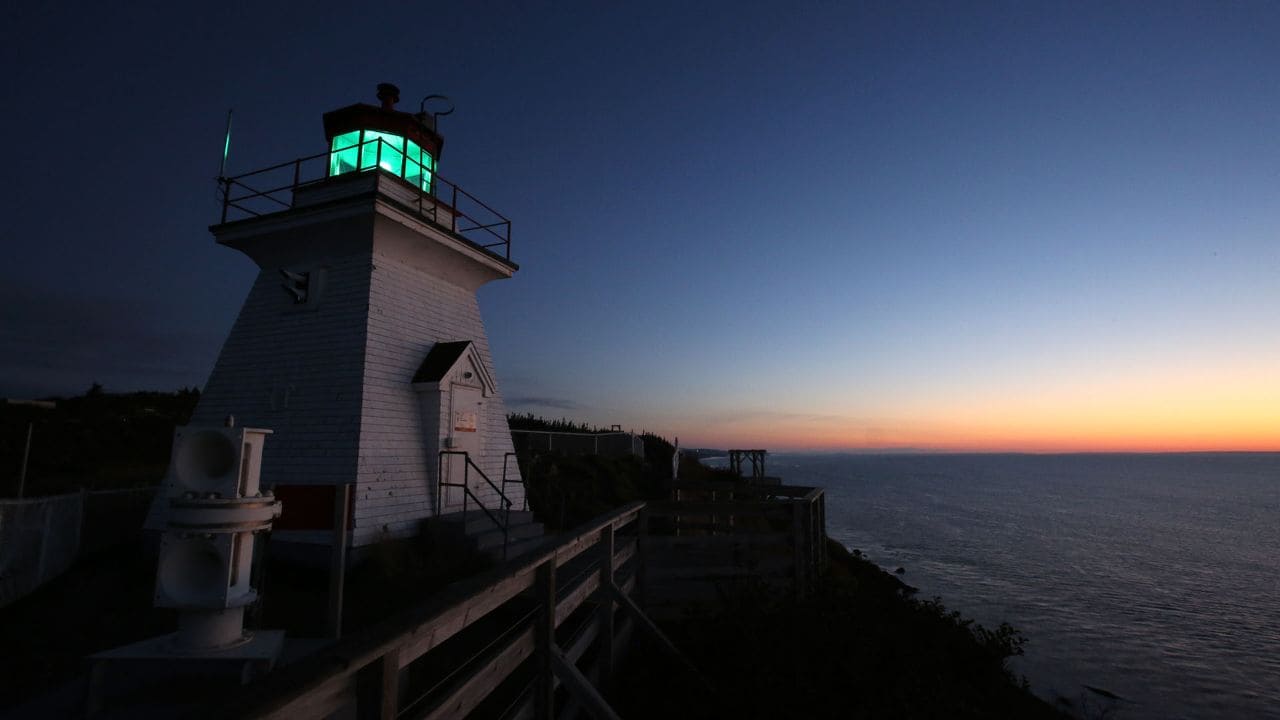The Phenomenal Bay of Fundy

Story and photos by Charles Williams
Charles is the editor of Pursuits with Enterprise. Email the author.
New Brunswick’s coastal communities live with the pulse of the ocean, which provides an unforgettable experience.
In a fairy-tale world of flowerpot rocks, reversing waterfalls and spouting whales, I rediscovered the joy of travel.
And just when I thought I’d seen it all, something strange happened — the ocean disappeared. It shouldn’t have come as a surprise because it happens twice a day, every day, along New Brunswick’s eastern coast.
The Bay of Fundy is a magical body of water between the Canadian provinces of New Brunswick and Nova Scotia. The tides here have the greatest shift in the world — up to 50 feet every 6 hours and 13 minutes. That’s higher than a four-story building.
During a 12-hour period, 100 billion tons of water flow in and out of the bay. The constant churn of water and dirt is so great, the tides create “rivers of chocolate.”
These tides noticeably affect all New Brunswick’s coastal communities. It’s as if Mother Nature frequently taps residents on the shoulder to remind them who sets the agenda. Locals accept the phenomenon as a fact of life; travelers shouldn’t fight it, either. Grab a tide chart, and pack a sense of adventure.
The Hopewell Rocks is the best place to witness the dramatic tidal changes. In 1936, Robert Ripley of “Ripley’s Believe It or Not” visited and said the 17 freestanding formations — goblet-shaped sandstone pillars with trees on top — were the world’s largest flower pots. The name stuck.
During low tide, the ocean retreats so far that vast crevices appear in the mud flats that were recently beneath water. In all my travels, I’ve never seen a more dramatic change in the landscape in such a short period of time.
New Brunswick fishermen literally struggle to stay afloat. Boats routinely leave Alma to catch lobster, scallops and haddock, but hours later, the remaining boats sit resting on blocks in the drained harbour. In Saint John, a series of rapids flows into the bay, but when the tide turns high, the direction of the river changes, creating the appearance of “Reversing Falls.”
Throughout the area, the watery veil is pulled back to expose tide pools, seaweed and even the secret caves of St. Martins. But the bay’s impact extends beyond the coastal communities.
The churn of the ocean stirs up whale food, and as many as 12 species visit the bay in summer, including minke, finback, humpback and the endangered northern right whale, which I was lucky enough to see up close. Whale watching tours depart from the town of St. Andrews, considered one of the most charming in North America. Splurge here and get a boat. Few experiences rival hearing a massive whale breathe and then watching it slip quietly beneath the surface.
To appreciate some of the challenges mariners face, drive to the lighthouse at Cape Enrage, which warns ships about dangerous, rocky cliffs. Since 1838, a lighthouse and fog alarm have operated here. The current lighthouse is 140 years old, and its perch, some 161 feet above the water, offers great views.
Fundy National Park straddles the bay and has 28 hiking trails, including many along the coast and through the forests; several of them lead to beautiful, secluded waterfalls. During autumn, maples, yellow birches, aspen and beech explode with color. The park is along the Atlantic migration route for birds, and over 260 species have been identified in the area.
If you prefer driving to hiking, the Fundy Trail Parkway begins at St. Martins and winds up the scenic coast toward the park, passing overlooks, beaches and a suspension footbridge. Eventually, this beautiful stretch of road will connect directly to the National Park.
And finally, all roads seem to lead to a covered wooden bridge. Spanning creeks throughout New Brunswick, the weathered structures are delightful, nostalgic accents in the peaceful countryside.
The joy of discovery drives travelers to take chances and seek out unfamiliar destinations. The Bay of Fundy rewards that urge with dramatic tides, incredible wildlife and beautiful scenery. As modern-day explorers, we know there’s no greater feeling than finding a fascinating spot that remains relatively unknown — at least for now.
Delightful St. Andrews offers simple pleasures
New Brunswick’s resort town is a great getaway for a family vacation or romantic weekend.
Prince Edward Island Beckons Lighthouse Lovers
Canada’s smallest province has the largest concentration of lighthouses.
Prince Edward Island Inspires
The classic novel “Anne of Green Gables” is set here, but that's only part of the island’s allure.
The Phenomenal Bay of Fundy
New Brunswick’s coastal communities live with the pulse of the ocean, which provides an unforgettable experience.
Cabot Trail Drive is a Quest for the Best
Rich culture, great seafood and lively music distinguish this Nova Scotia journey from all others.
Quebec City is the Perfect Romantic Weekend Getaway
Two empty nesters seek a new beginning in Quebec, Canada.
Ottawa Abounds With Historical Attractions
Canada’s capital brims with worthwhile pursuits in a gorgeous setting.
Algonquin Park Scenic Drive
Ontario’s largest provincial park influenced some of Canada’s most iconic art.
Niagara Falls’ Spectacular Beauty is Timeless
Lovers, families and risk-takers converge at a water wonderland.
Tofino’s Not-So-Hidden Hot Springs
It’s a fun day trip from the Canadian hotspot, but don’t expect solitude and tranquility.
Weekend Getaway to Victoria, Canada
Food, attractions and friendly community draw visitors to British Columbia’s capital city.
A Mother-Daughter Road Trip on the Pacific Marine Circle Route
A world traveller explores southern Vancouver Island and looks for a place to call home.








































